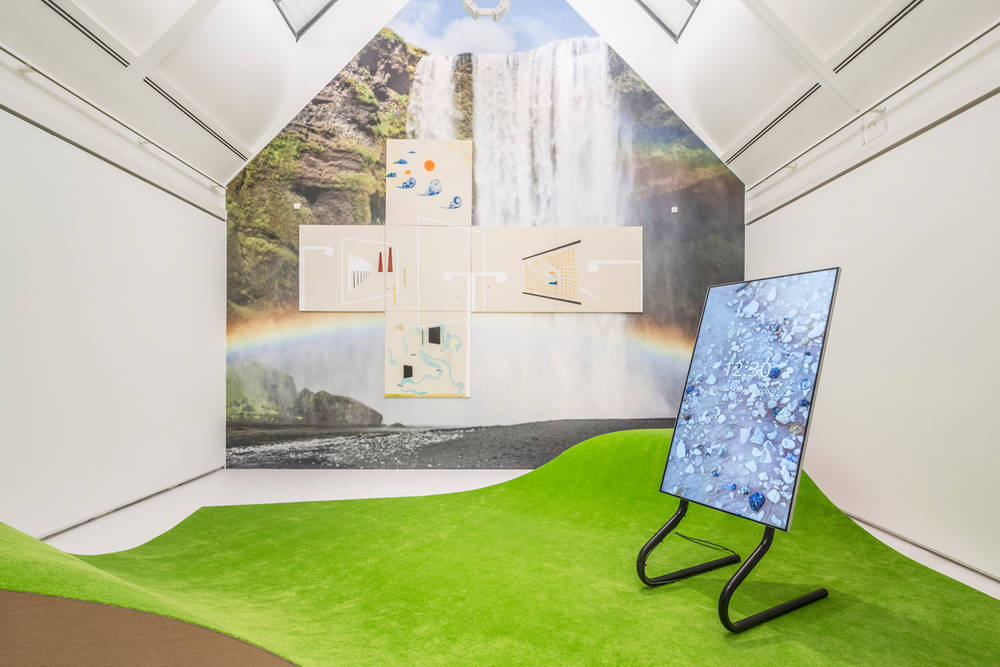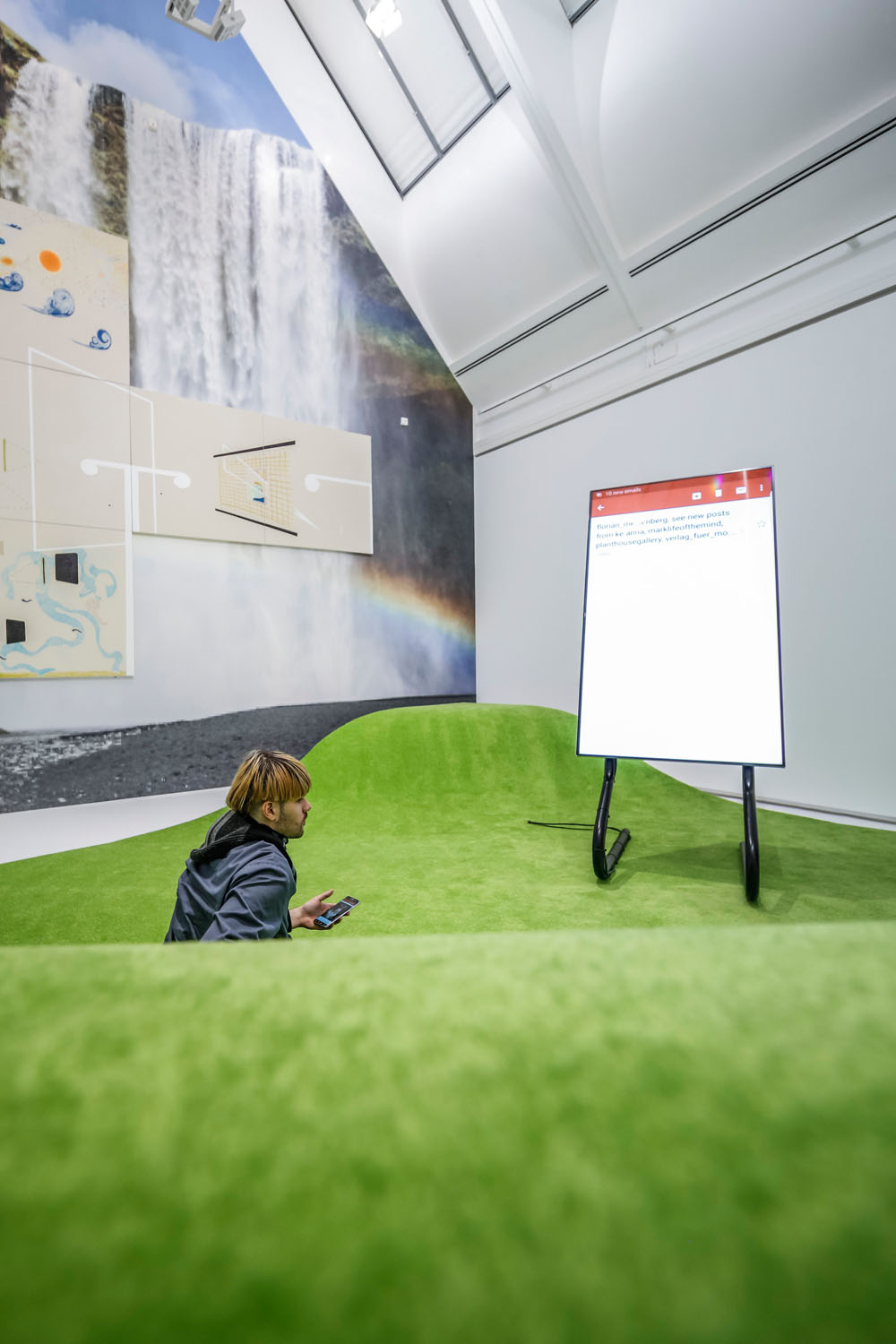For three months artist Florian Meisenberg published his digital private sphere as a live-stream. An interview about his initial experiences and his understanding of virtual realities.
Born in Berlin, New York-based artist, while still studying at Düsseldorf Kunstakademie Florian Meisenberg began expanding his painterly practice with videos, performances and virtual projects. He melds analog and digital aesthetics and plays them off against each other. Meisenberg’s installation “Out of Office” (2016), which is currently on display in the “ME” exhibition in the SCHIRN, consists of a large wallpaper depicting a waterfall, a painting in a format shaped like a cross, and a monitor which is attached to two thin legs. On the latter, visitors can follow live everything he does using his Smartphone. And thanks to GPS he can also be stalked online and his location pinpointed. Photos, news, appointments – everything is on show. We talked with him about his live-stream experiment, and about virtual and real realities – a digital dialogue that can of course also be followed live in the exhibition.
Florian, you do not have a digital private sphere at the moment. Which naturally prompts the question: Do you believe that something like a digital private sphere actually exists?
Oh yes, very much so. But only because we stage it. Generally speaking I find it dubious that we want to import our logic, laws, moral and our (I) consciousness almost 1-to-1 into the digital sphere. By doing that we radically limit the Internet’s openness and what you can do with it. Primarily, profit-driven minds seem to be at work there. This seems to be a deeply rooted, human characteristic.
Is it not also the case that the Internet serves as a platform for an enriched self-portrayal? Shy people voice their opinions here, and “sharing” extends as far as the bedroom. Shouldn’t one talk of a second “Me” rather than a simulation?
Yes, I suppose so, but actually this elaboration takes place in a very primitive or rudimentary manner. I would like to see the Internet become the next mind-expanding drug. You put it very well; a second Me. Bianca becomes Beate21.
The avatar, so to speak.
Yes, but only a poor copy of the real person.

In his preface to the exhibition catalog Max Hollein emphasizes the topic of posing. Naturally, staging your digital personality also plays a role in your live-stream. Has your online behavior altered since the exhibition began?
Needless to say, I can’t say exactly how and in what way but it has definitely altered. After all, exposing myself like this for three months through the live-stream is an experiment. What interests me right now is the juxtaposition to something as far removed from reality as painting. There is something tragic about it, but also something humorous. You could say the painted image is likewise composed from data. Just that it is compressed like a zip file.
The painting in question in the “Out of Office” installation is entitled “Beaches of the lonely Men” and outwardly it cites the texture of an unfolded skybox – a method used in video games to make backgrounds appear larger than they are. But the shape evokes a horizontal cross. Do religion and computer games as concepts for constructed realities “so far removed from reality”, as you just put it, come together in the painting?
Yes, I think so. After all, religion, computer games, and painting, too, are all largely simulations, which either play with illusion, or question the reality of a virtual space, or avail themselves of this illusion. Thanks to the special architecture of the SCHIRN the entire room acquires something religious about it. After all, these three levels are not congruent simulations, but reflect varying spaces of the human psyche and social-sociological questions. It was really exciting, for example, to see how visitors responded to the installation.

And how did they?
The reactions differed greatly. There were large numbers of visitors at the opening and there was a large flow of people that slowly but surely approached my installation in the last room of the exhibition, and then stopped in front of the entrance. Hardly anyone seemed able or willing to enter. They were all really fascinated but regarded the whole thing with great suspicion. Almost accusingly. The next morning the experience could not have been more different.
No sign of reservations among the young generation?
:)
You allude to illusion and the question of virtual reality with the pixeled mural depicting a kitschy waterfall. Although nature actually forms a contrast to the digital sphere, here it acts as a backdrop, is presented like a template. A digital landscape – the idyllic home of your avatar?
You can also see this wallpaper as a side of the skybox in the context of the exhibition, or exhibition architecture. As such, it is not only a virtual expansion of my installation, but also of the entire exhibition, which however does not end with a white wall, but with a digital simulation of space. How much nature then remains is an interesting question.

You often merge analog and digital realities in your works: paintings and exhibition architectures refer to digital aesthetics while you address real intimacy in your digital works. For example, your partner’s body, greasy smears left by fingers on a screen, or the latter’s function as a mirror. How would you describe the relationship between the analog and digital in the installation “Out of Office”, which, after all, includes both elements?
I feel strongly motivated to explore the various potentials of both spheres and to play them off against each other. The simultaneous juxtaposition in digital and real space serves in the work to reflect the human aspect. It opens up questions and reveals insights that would otherwise remain hidden to us. To me the different spatial and temporal perception in painting and in live-streams, not to mention their absolute subjectivity, suggests a strange interstice. I find it exciting to present social phenomena in a fresh manner, for example to show how intimacy can be simulated in the digital sphere. The question arises whether intimacy is necessary at all there. And what quality and force can the absurdly static and anachronistic medium of painting have in the confrontation with the sheer mass of digital images? Thanks to the religious quality, the space almost comes across like a place for absolution – liberating you from all sins. As through the live transmission I liberate visitors from their human responsibility as users in the never ceasing stream of data, and from confrontation with the infinity of simultaneous phenomena in the web.
Typically, you don’t use a grounding in your paintings, but have the permeable material emphasize colorless oil stains, which either form around oil colors or shift to the center in place of a theme. Is your intention in bringing out the stain on the canvas to emphasize the human element, or the intimate physical quality?
Of course. There is something immaculate and pure or almost virginal about the bared canvases. Which makes them the perfect foundation for the stream of references inherent in my pictures. Precisely through this visualizing of the raw components, physical presence is heightened, and as such the reference to the human per se. In other words, pigment, oil and canvas.
In an earlier video work “HOW TO COPY MY SIGNATURE” from 2011 you used a tutorial format to show your YouTube viewers how to copy your signature. What kind of connection do you see between the issue of copyright and the digital self-portrait?
A very close one, for example, in any attempt to produce authentic or original digital data. It makes no sense of all to apply the laws and rules of profit and logic to the digital sphere; it’s all part of the capitalist colonialization of the Internet. I would like the “me” in the Web to definitely be absolutely transparent.
As transparent as the canvas of your paintings ...
Yes, perhaps as transparent. Copyright in the Web is absolutely absurd. It goes against the real idea, almost like a Dadaist performance.
Concurrently with the “ME” exhibition in the SCHIRN, you are exhibiting with your partner Anna K.E. in the Frankfurt project space Salon Kennedy. What is your collaborative project “COUNTDOWN BELLADONNA” about?
The central element of the exhibition is a 2-channel video piece. For over a month Anna and I filmed our eyes and what is reflected in them using a 4k-camera and a good macro lens. It was a series of film sequences, Facebook moments and YouTube fragments, which each of us curated for the other person’s eyes. In the exhibition these macro shots of the eyes are played on very large screens so that the reflections of our Smartphone displays in the eye almost achieve the original size.
Do you see emotions?
Oh, yes, very much so. That said, highly abstract. For example, there is a scene where Anna cries. We are all familiar with the eye, but it is alienated thanks to the incredible enlargement. It is charged with something mystic and metaphysical – also because of the mixture of human reactions with the digital reflections of the sheer mass of images that come crashing down on us from the screen.
Florian, thank you for this conversation!

How Hip Hop sings about its dead
Death plays a large part in Hip Hop. The tragic early passing of legends such as Biggie Smalls and Tupac, not to mention rising superstars like...

5 questions for Mary Messhausen and proddy produzentin
With the performance "Thonk piece: Hungry for Stains", drag queens Mary Messhausen and proddy produzentin will open the exhibition COSIMA VON BONIN....

HIP HOP IS BLACK CULTURE – NOT THE OTHER WAY AROUND
Hip hop’s 50th birthday is an occasion for us to listen to some old records and mixed tapes and to look back at the most important hip hop films of...

Now at the SCHIRN:COSIMA VON BONIN
The SCHIRN is showing a unique presentation of new and well-known works by COSIMA VON BONIN until June 9.

You Get the Picture: On Movement and Substitution in the Work of Lena Henke
The artist LENA HENKE already exhibited in the SCHIRN Rotunda in 2017. What are the secrets of her practice and where can you find her art today?

SHALLOW LAKES – plumbing the depths
In the SCHIRN’s rotunda, MELIKE KARA is presenting a series of sculptures that are reminiscent of bodies of water or small lakes. So, what’s this...